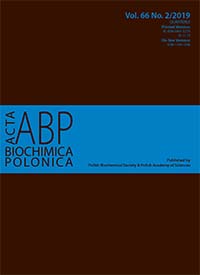Application of transition metal ions in a study of photoinduced modifications of melanin
Abstract
Short wavelength visible light is viewed as the main agent responsible for oxidative modification of melanin in the human retinal pigment epithelium (RPE). The aim of this research was to study light-induced modifications of melanin using iron and zinc as molecular probes. A synthetic model of eumelanin was treated by intense violet light. The interaction of melanin with metal ions was examined by electron paramagnetic resonance (EPR) spectroscopy and a thiocyanate assay. Weak photodegradation of melanin was shown to increase exposure of melanin subunits, while stronger photodegradation caused a loss of melanin subunits. Iron-binding in such melanin was weak and nonspecific.
Acta Biochimica Polonica is an OpenAccess quarterly and publishes four issues a year. All contents are distributed under the Creative Commons Attribution-ShareAlike 4.0 International (CC BY 4.0) license. Everybody may use the content following terms: Attribution — You must give appropriate credit, provide a link to the license, and indicate if changes were made. You may do so in any reasonable manner, but not in any way that suggests the licensor endorses you or your use.
Copyright for all published papers © stays with the authors.
Copyright for the journal: © Polish Biochemical Society.


